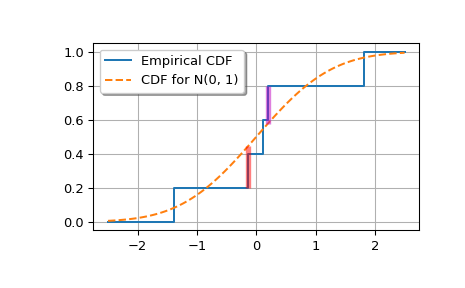scipy.special.smirnov#
- scipy.special.smirnov(n, d, out=None) = <ufunc 'smirnov'>#
Kolmogorov-Smirnov 互补累积分布函数
返回Kolmogorov-Smirnov互补累积分布函数(即生存函数)的精确值,用于检验基于`n`样本的经验分布与理论分布之间相等性的一侧检验。它等于基于`n`样本的理论分布与经验分布之间的最大差异大于d的概率。
- 参数:
- n整数
样本数量
- d浮点数 类数组
经验累积分布函数 (ECDF) 与目标累积分布函数之间的偏差。
- 出ndarray,可选
函数结果的可选输出数组
- 返回:
- 标量或ndarray
smirnov(n, d) 的值,Prob(Dn+ >= d) (同样 Prob(Dn- >= d))
参见
smirnovi分布的逆生存函数
scipy.stats.ksone提供作为连续分布的功能
kolmogorov,kolmogi双边分布的函数
注释
smirnov在应用 Kolmogorov-Smirnov 拟合优度检验时被 stats.kstest 使用。出于历史原因,此函数在 scpy.special 中暴露,但推荐使用 stats.ksone 分布来实现最准确的 CDF/SF/PDF/PPF/ISF 计算。示例
>>> import numpy as np >>> from scipy.special import smirnov >>> from scipy.stats import norm
显示样本大小为5时,间隙至少为0、0.5和1.0的概率。
>>> smirnov(5, [0, 0.5, 1.0]) array([ 1. , 0.056, 0. ])
将大小为5的样本与N(0, 1)进行比较,N(0, 1)是均值为0、标准差为1的标准正态分布。
x 是样本。
>>> x = np.array([-1.392, -0.135, 0.114, 0.190, 1.82])
>>> target = norm(0, 1) >>> cdfs = target.cdf(x) >>> cdfs array([0.0819612 , 0.44630594, 0.5453811 , 0.57534543, 0.9656205 ])
构建经验累积分布函数和K-S统计量(Dn+,Dn-,Dn)。
>>> n = len(x) >>> ecdfs = np.arange(n+1, dtype=float)/n >>> cols = np.column_stack([x, ecdfs[1:], cdfs, cdfs - ecdfs[:n], ... ecdfs[1:] - cdfs]) >>> with np.printoptions(precision=3): ... print(cols) [[-1.392 0.2 0.082 0.082 0.118] [-0.135 0.4 0.446 0.246 -0.046] [ 0.114 0.6 0.545 0.145 0.055] [ 0.19 0.8 0.575 -0.025 0.225] [ 1.82 1. 0.966 0.166 0.034]] >>> gaps = cols[:, -2:] >>> Dnpm = np.max(gaps, axis=0) >>> print(f'Dn-={Dnpm[0]:f}, Dn+={Dnpm[1]:f}') Dn-=0.246306, Dn+=0.224655 >>> probs = smirnov(n, Dnpm) >>> print(f'For a sample of size {n} drawn from N(0, 1):', ... f' Smirnov n={n}: Prob(Dn- >= {Dnpm[0]:f}) = {probs[0]:.4f}', ... f' Smirnov n={n}: Prob(Dn+ >= {Dnpm[1]:f}) = {probs[1]:.4f}', ... sep='\n') For a sample of size 5 drawn from N(0, 1): Smirnov n=5: Prob(Dn- >= 0.246306) = 0.4711 Smirnov n=5: Prob(Dn+ >= 0.224655) = 0.5245
绘制经验累积分布函数和标准正态累积分布函数。
>>> import matplotlib.pyplot as plt >>> plt.step(np.concatenate(([-2.5], x, [2.5])), ... np.concatenate((ecdfs, [1])), ... where='post', label='Empirical CDF') >>> xx = np.linspace(-2.5, 2.5, 100) >>> plt.plot(xx, target.cdf(xx), '--', label='CDF for N(0, 1)')
添加标记 Dn+ 和 Dn- 的垂直线。
>>> iminus, iplus = np.argmax(gaps, axis=0) >>> plt.vlines([x[iminus]], ecdfs[iminus], cdfs[iminus], color='r', ... alpha=0.5, lw=4) >>> plt.vlines([x[iplus]], cdfs[iplus], ecdfs[iplus+1], color='m', ... alpha=0.5, lw=4)
>>> plt.grid(True) >>> plt.legend(framealpha=1, shadow=True) >>> plt.show()
